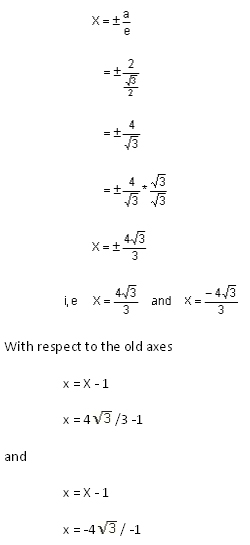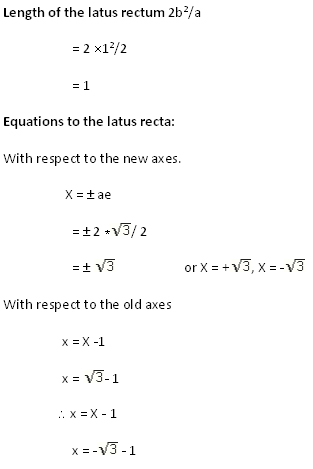Equation of an ellipse in its standard form
x2/a2 + y2/b2 =1
Let S be the focus, ZK the directrix and e the eccentricity of the ellipse whose equation is required.
Draw SK perpendicular to ZK from S. Divide SK internally and externally at A and A1 (A1 lies on KS produced) respectively in the ratio e:1.
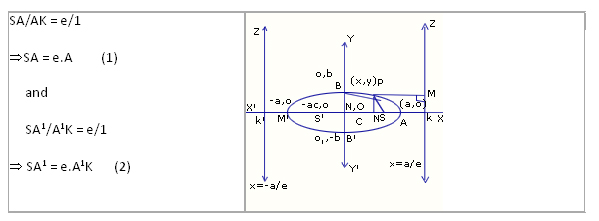
The points A and A1 are points such that their distances from the focus bear a constant ratio e to their respective distances from the directrix. Therefore, A, A1 lie on the ellipse.
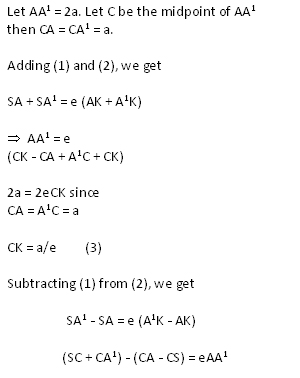
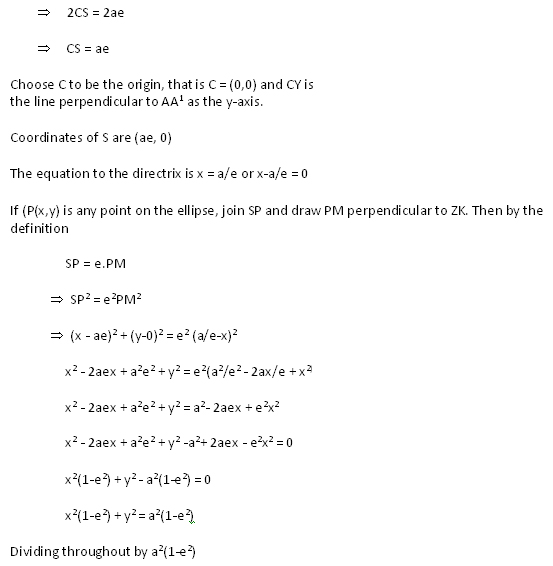
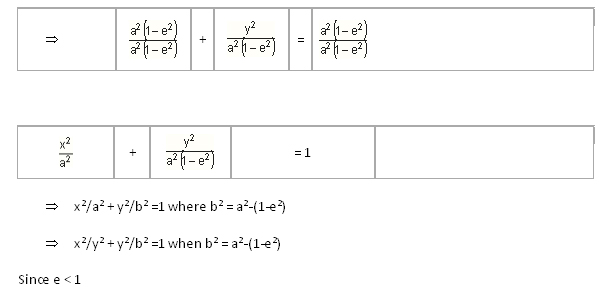
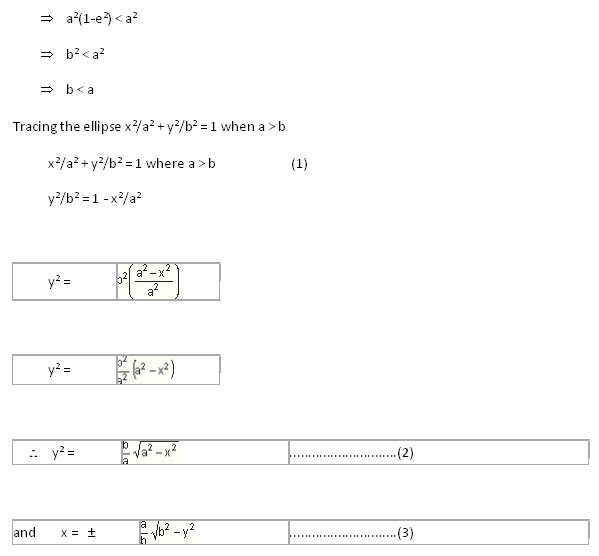
To trace the ellipse use the following points.
- Symmetry
For every value of x, there are equal and opposite values of y (from equation (2)), and for every value of y there are equal and opposite values of x (from equation (3)).
So the curve is symmetric about both the axes.
- Origin:
The curve does not pass through the origin.
- Intersection of the axes:
The curve meets x axis at y = 0. Putting y = 0 in equation (3), we get
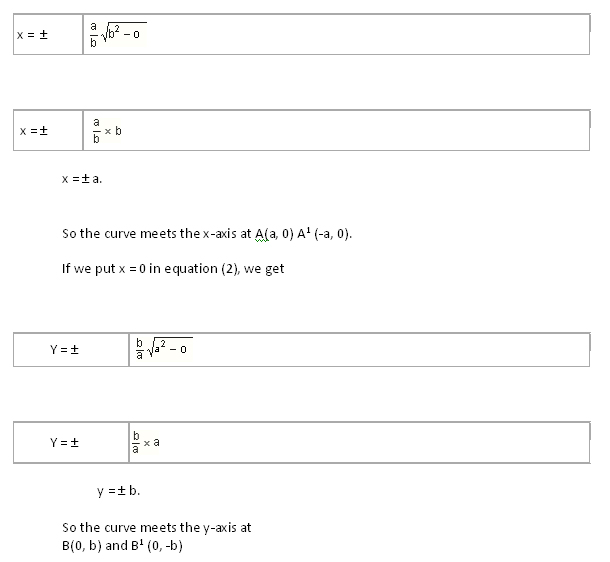
- Region
If x > a or x < -a then a2 - x2 < 0, we get imaginary values for y. Therefore, no part of the curve exists to the left of A1 and to the right of A.
If y > b or y < -b
then x has imaginary values and we get no part of the curve below B1 and above B.
From equation (2), we find that at x = 0, y = ± b and as the x values increase, the y values decrease so that y= 0 at x=a.
Therefore, the curve is a closed curve.
From equation (2), we find that at x = 0, y = ± b and as the x values increase, the y values decrease so that y= 0 at x=a.
Therefore, the curve is a closed curve.
Second focus and second directrix of an ellipse
In the figure of the ellipse given earlier, P(x,y) is a point on the curve and we have
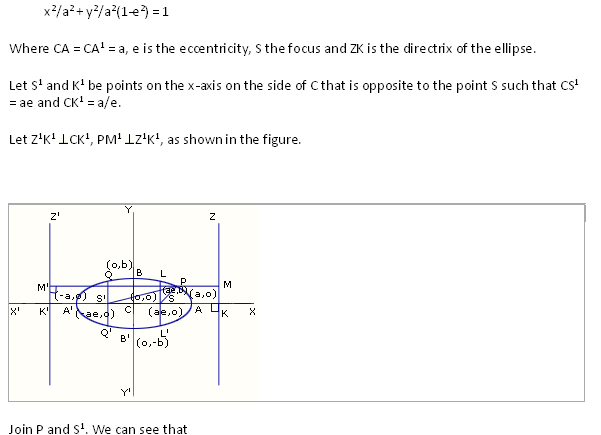
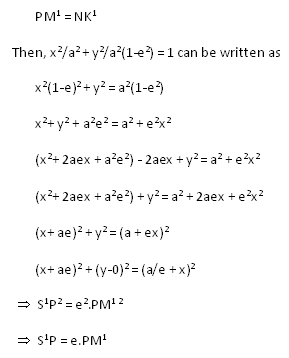
This is the condition for the same ellipse. Since we started with S1 as the focus and Z1K1 as directrix, we have a second focus S1(-ae, 0) and a second directrix x = -a/e.
Parts of the ellipse x2/a2 + y2/b2 = 1 a>b
Vertices:
The points A and A1 where the ellipse meets the line joining the foci are called the vertices of the ellipse, and are (a,0) and (-a,0).
Foci:
The points S(ae,0) and S1(-ae,0) are called the foci of the ellipse.
Major and Minor Axes:
The distances AA1 = 2a and BB1 = 2b are called the major and minor axes, respectively.
Since e < 1 a>b
AA1 > BB1
Directrices:
ZK and Z1K1 are the two directrices of the ellipse and their equations are x = a/e and x = -a/e, respectively.
Center:
The center of a conic section is a point that bisects every chord passing through it. In the ellipse, every chord passing through C is bisected at C(0,0).
C is the center of the ellipse. C is the midpoint of AA1 and BB1.
Eccentricity:
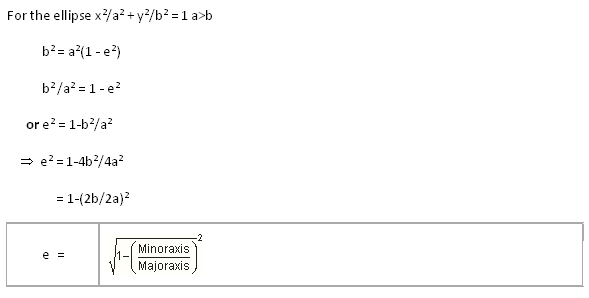
Ordinate and Double Ordinate
Let P be a point on the ellipse and let PN be perpendicular to the major axis AA1 such that PN meets the ellipse at P1. Then, PN is called the ordinate of P and PNP1 is called a double ordinate.
Latus rectum:
It is a double ordinate passing through the focus.
In the figure, LSL1 is the latus rectum, LS is called the semi-latus rectum.
The coordinates of L are (ae,SL)
L lies on x2/a2 + y2/b2 = 1
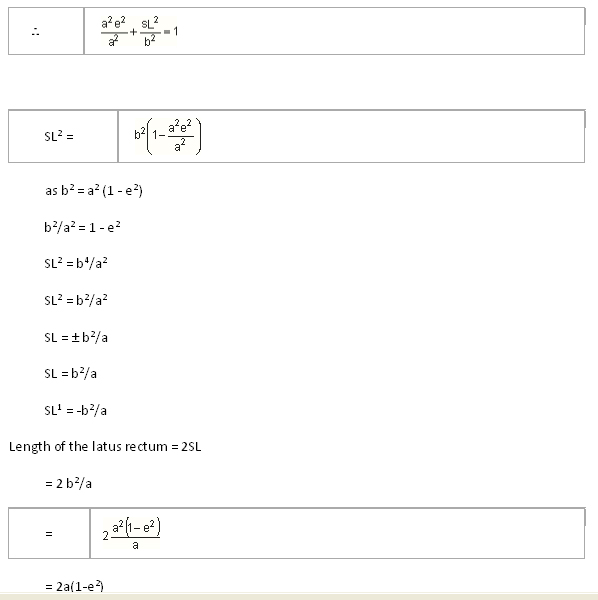
Focal distances of a point on an ellipse
If P(x,y) is a point on the ellipse, then the distances SP and S1P are the focal distances.
SP = ePM = eNK = e(CK-CN) = e(a/e-x) = a-ex
S1P = ePM1 = eNK1 = e(CK1-CN) = e(a/e+x) = a+ex
5.4.6 Equation of an ellipse in another form
The ellipse given by x2/a2 + y2/ b2 = 1 a>b has its major and minor axes on the x-axis and y-axis, respectively.
If, however, x2/a2 + y2/b2 = 1 a<b, then BB1 becomes the major axis and AA1 the minor axis.
The coordinates of the foci are (0,be), (0,-be), the equations to the directories. ZK and Z1K1 are y = ± b/e, where e is the eccentricity given by the formula.
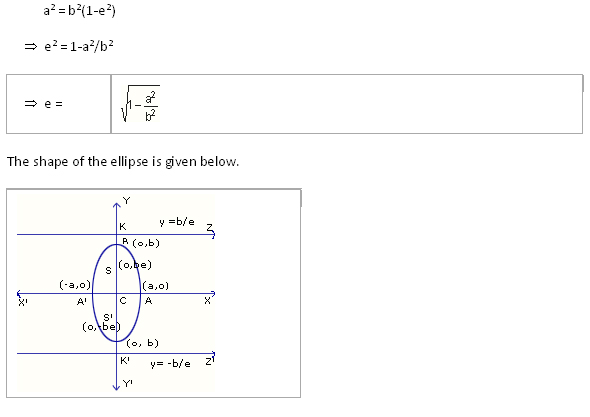
Equation of the ellipse |
x2/a2 + y2/b2 = 1 a>b |
x2/a2 + y2/b2 = 1 a<b |
Coordinates of the center |
(0,0) |
(0,0) |
Coordinates of the vertices |
(a,0), (-a,0) |
(0,-b), (0,b) |
Coordinates of the foci |
(ae,0), (-ae,0) |
(0,be), (0,-be) |
Length of the major axis |
2a |
2b |
Length of the minor axis |
2b |
2a |
Equation of the major axis |
y = 0 |
x = 0 |
Equation of the minor axis |
x = 0 |
y = 0 |
Equations of the directrices |
x = a/e x = -a/e |
y = b/e y= -b/e |
Eccentricity |
|
|
Length of the latus rectum |
2b2/a |
2a2/b |
Focal distance of a point (x,y) |
a ± ex |
b± ey |
Special form of an ellipse
If the center of the ellipse is at a point (h,k) and the directrices of the axes are parallel to the coordinate axes, then its equation is

We shift the origin (0,0) to the point (h,k).
Example 2
Find the equation of an ellipse whose focus is (-1,1), the directrix is x-y+3=0 and the eccentricity is 1/2.
Let P(x,y) be a point on the ellipse. If PM = perpendicular from P, the directrix is
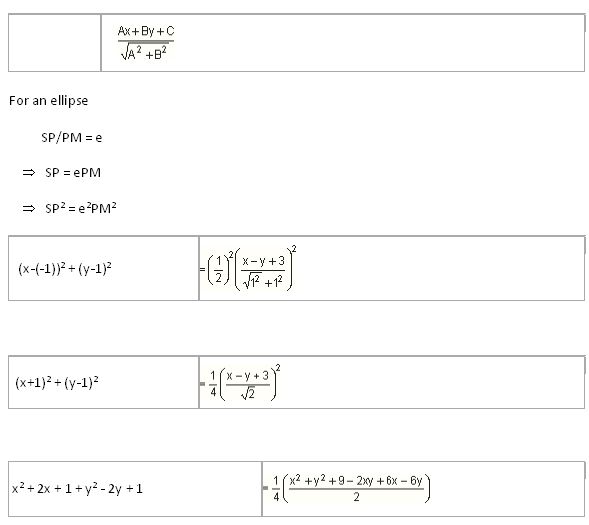
By cross-multiplying
8(x2 + y2 + 2x - 2y + 2) = x2 + y2 + 9 - 2xy + 6x - 6y
8x2 + 8y2 + 16x - 16y - x2 - y2 - 9 + 2xy - 6x + 6y = 0
7x2 + 7y2 + 2xy + 10x - 10y + 7 = 0
Example 3
For the following ellipse, find the lengths of the major and minor axes, coordinates of the foci, vertices and eccentricity.
- 16x2 + 25y2 = 400
- 3x2 + 2y2 = 6
- x2 + 4y2 - 2x = 0
Solution:

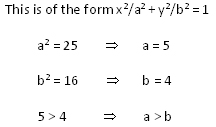
- Major axis is along the x-axis
Minor axis is along the y-axis
Length of the major axis = AA1 = 2a = 2 * 5 = 10
Length of the minor axis = BB1 = 2b = 2 * 4= 8
Vertices:
Vertices are (a, 0), (-a, 0)
or (5, 0), (-5, 0)
- Eccentricity



- = 3/5
- Foci:
Coordinates are (ae,0), (-ae,0)


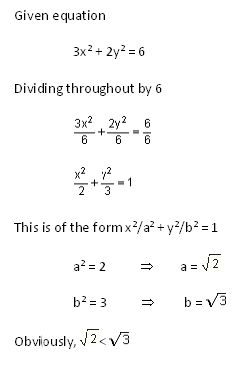
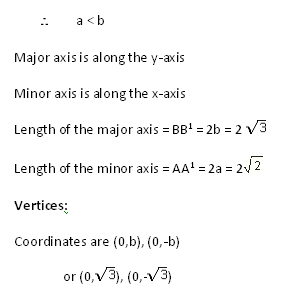 Eccentricity:
Eccentricity:
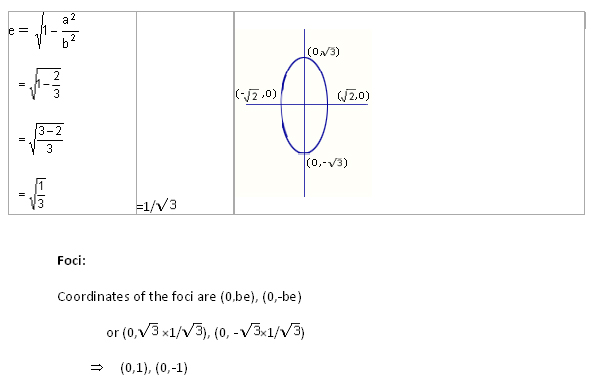
- Solution:
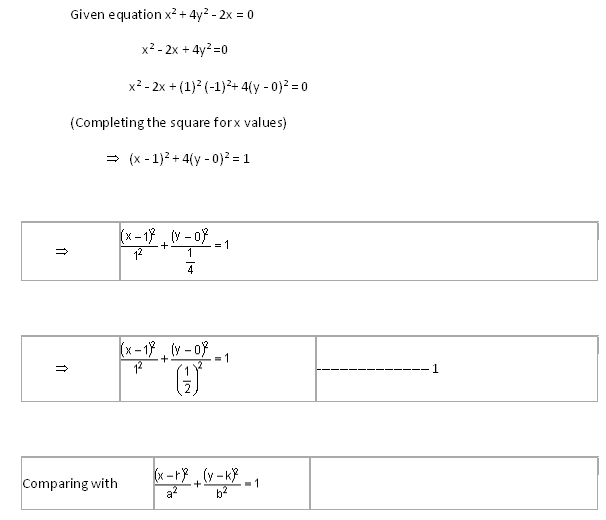
the origin (0,0) becomes (1,0) as h=1, k=0.
Shifting the origin to (1,0), we obtain the new coordinates X,Y as
x - 1 = x x = x + 1
y - 0 = y or y = y
Equation (1) reduces to
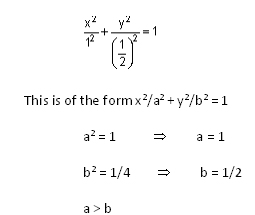
Major axis is along the x-axis
Minor axis is along the y-axis
Length of the major axis = 2a = 2 * 1= 2
Length of the minor axis = 2b = 2 * 1/2 = 1
Eccentricity:

Vertices:
Coordinates of vertices with respect to the new axes are (a, 0), (-a, 0)
(X, 0) = (1, 0), (-X, 0) = (-1, 0)
With respect to old axes
x = X + 1
= 1 + 1
= 2
x = -X + 1
= -1 + 1
= 0
(2,0), (0,0)
Foci:
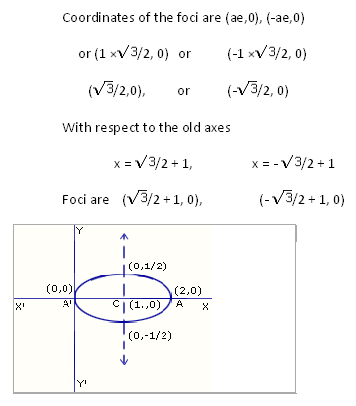
Example 4:
Find the eccentricity, center, vertices, foci, minor axis, major axis, directrices and latus rectum of the ellipse
Solution:
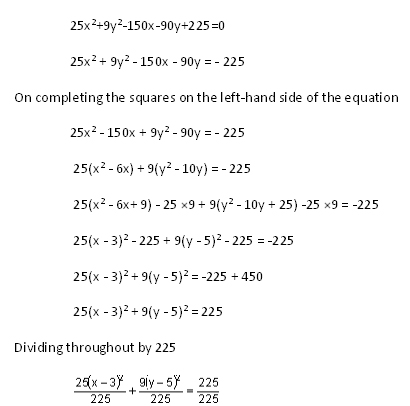
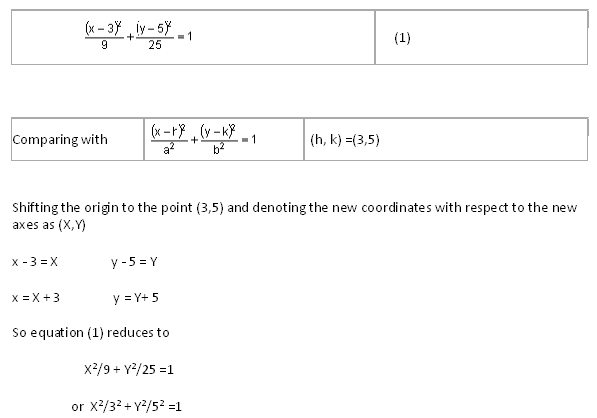
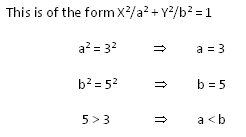
Eccentricity:
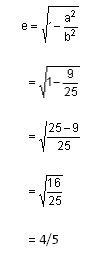
Center:
Coordinates with respect to the new axes (X,Y) = (0,0)
With respect to the old axes
x = X + 3
= 0 + 3
= 3
y = Y + 5
= 0 + 5
= 5
Center (3,5)
Vertices:
Coordinates with respect to the new axes are (0,b), (0,-b) = (0,5), (0,-5)
With respect to the old axes
x = X + 3
x = (0+3)
= 3
x = (0+3)
= 3
y = 5 + 5
= 10
y = - 5 + 5
= 0
Vertices are (3,10), (3,0)
Foci:
With respect to the new axes foci are (0,be), (0,-be) or
(0, 5 *4/5), (0, -5 *4/5)
(0,4), (0,-4)
With respect to the old axes
x = X + 3
= 0 + 3
= 3
x = X + 3
= 0 + 3
= 3
y = Y + 5
y = 4 + 5
= 9
y = Y + 5
= -4 + 5
= 1
Foci are (3,9), (3,1)
Directrices:
With respect to the new axes, the equations are
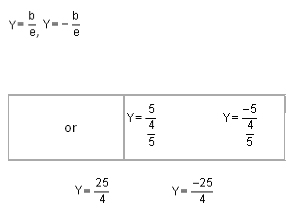
With respect to the old axes
y = Y + 5
= 25/4 + 5
y = 25 + 20/4
y = 45/4
or 4y - 45 = 0 |
y = Y + 5
= - 25/4 + 5
y = -25+20/4
y = -5/4
4y + 5 = 0 |
Length of the major axis = 2b = 2 * 5 = 10
Length of the minor axis = 2a = 2 *3 = 6
Equation of the major axis with respect to the new coordinates is X = 0
With respect to the old axes is
x = X + 3
x = 0 + 3
x = 3
Equation of the minor axis with respect to the new coordinates is Y = 0
With respect to the old axes is
y = Y + 5
y = 0 + 5
y = 5
Latus rectum:
The length of the latus rectum

Equation of latus recta with respect to the new axes

With respect to the old axes
y = Y + 5
= 4 + 5
y = 9
y = Y + 5
= -4 + 5
y = 1
The figure of the ellipse is given below.
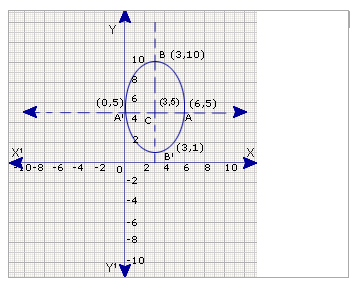
Try these questions:
- Find the center, foci, vertices, eccentricity, length of axis and directrices of the following ellipses. Draw a rough sketch.
- X2 + 4y2 - 4x + 24y + 31 = 0
- 3x2 + 4y2 - 12x - 8y + 4 = 0
- 16x2 + 4y2 - 32x - 24y - 12 = 0
- Show that x2 + 4y2 + 2x + 16y + 13 = 0 is the equation to an ellipse. Find its eccentricity, center, foci, vertices, directrices, length of the latus rectum and the equations of the latus recta.
Answers:
- Solution:
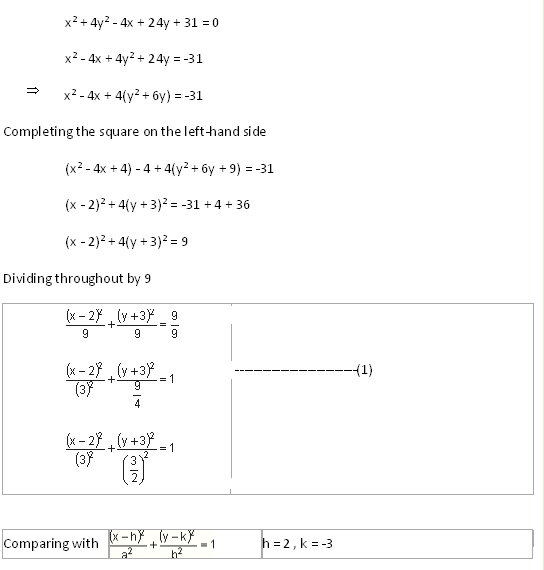
Shifting the origin to (-2, -3) and denoting the new coordinates with respect to the new axes, as X and Y
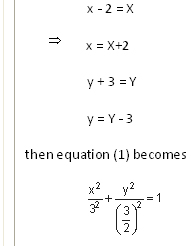
which is of the form x2/ a2 + y2/ b2 = 1
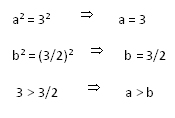
Eccentricity:
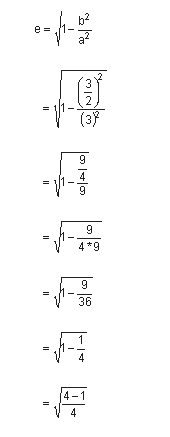
- Solution:
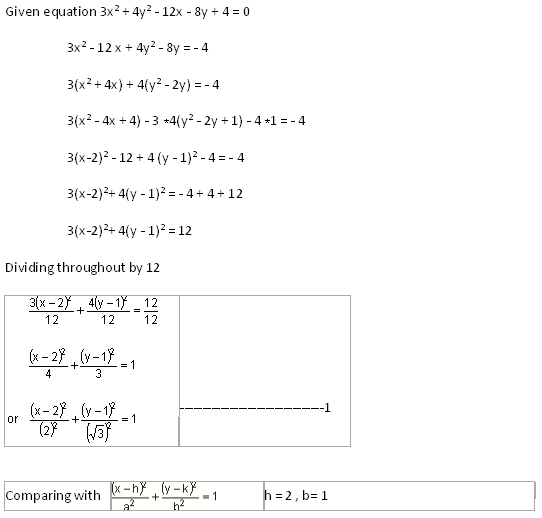
Shifting the origin to (2, 1) and denoting the new coordinates with respect to the new axes as X, Y
x - 2 = X
x = X + 2
y - 1 = Y
y = Y + 1
Equation (1) now becomes
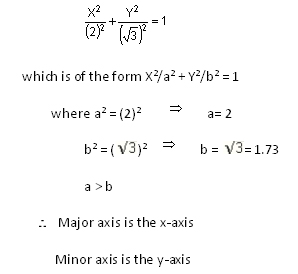
Eccentricity:
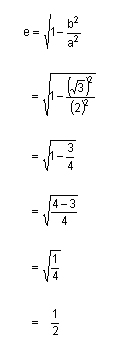
Foci:
With respect to the new axes the foci are (ae, 0), (-ae, 0)
= (2 *1/2, 0), (-2 *1/2, 0)
= (1, 0), (-1, 0)
With respect to the old axes
x = X + 2
= 1 + 2
= 3
y = Y + 1
= 0 + 1
= 1
and
x = X + 2
= - 1 + 2
= 1
y = Y + 1
= 0 + 1
= 1
Foci are (3, 1), (1,1)
Vertices:
With respect to the new axes are
(a, 0), (-a, 0)
= (2, 0), (-2, 0)
With respect to the old axes
x = X + 2
= 2+ 2
= 4
y = Y + 1
= 0 + 1
= 1
x = X + 2
= - 2+ 2
= 0
y = Y + 1
= 0 + 1
= 1
Vertices are ( 4, 1), (0, 1)
Center:
With respect to the new axes
(X, Y) = (0, 0)
With respect to the old axes
x = X + 2
= 0 + 2
= 2
y = Y + 1
= 0 + 1
= 1
Center (2, 1)
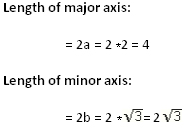
Directrices:
With respect to the new axes
X = a/e X = -a/e
X = 2/(1/2) X = -2/(1/2)
X = 4 X = -4
X - 4 = 0 X + 4 = 0
With respect to the old axes
x = X + 2 and x = X+ 2
x = 4 + 2 and x = -4 + 2
x = 6 and x = - 2
x - 6 = 0 and x + 2 = 0 are the directrices.
To find the values of the points where the ellipse cuts the minor axis or y-axis with respect to the new axis are
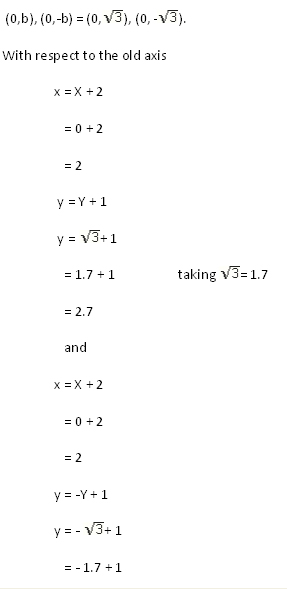
= - .7
Points are (2, 2.7), (2, - .7)
The figure of the ellipse is as follows.
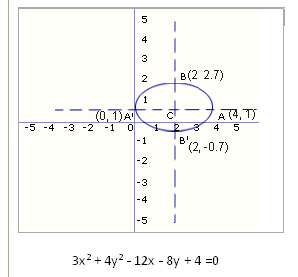
- Solution:
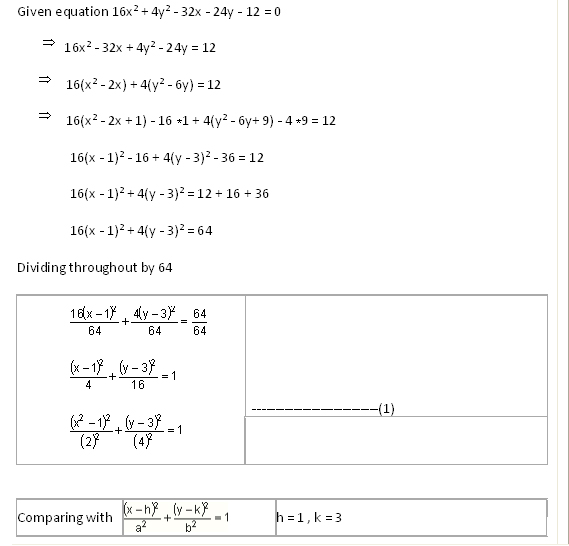
Shifting the origin to the point (1,3) and denoting the new coordinates with respect to the new axes as (X, Y)
x - 1= X
x = X + 1
and
y - 3= Y
y = Y + 3
Equation (1) now becomes
X2 / (2)2 + Y2 / (4)2 =1
This is of the form X2/a2 + Y2/b2 = 1
where a2 = (2)2 a = 2
- Solution:
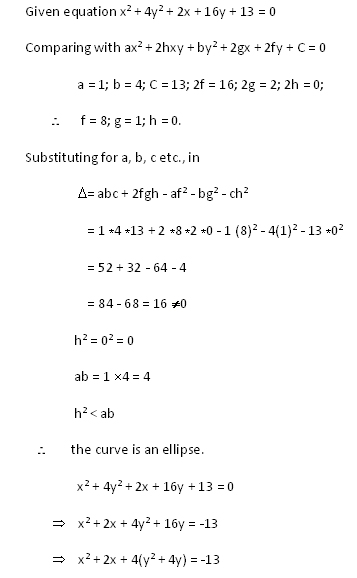
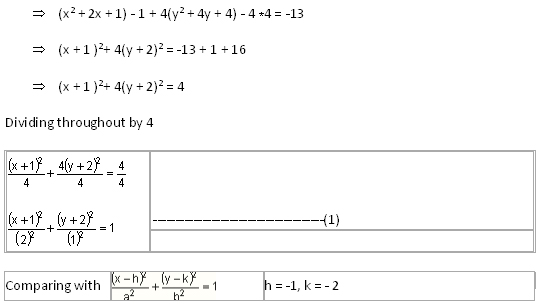
Shifting the origin to (-1, -2) and denoting the new coordinates with respect to the new axes as X,Y.
x + 1 = X
x = X - 1
y + 2 = Y
y = Y - 2
Equation (1) becomes
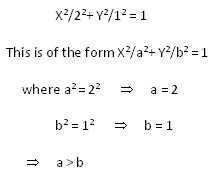
Major axis is the x-axis
Minor axis is the y-axis
Center:
With respect to the new axis ( 0, 0)
With respect to the old axis
x = X - 1
= 0 - 1
= -1
y = Y - 2
= 0 - 2
= -2
Center (-1, -2)
Eccentricity
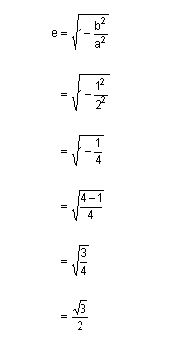
Vertices:
With respect to the new axes ( a, 0), (-a, 0)
= (2, 0), (-2, 0)
With respect to the old axes.
x = X - 1
= 2 - 1
= 1
y = Y - 2
= 0 - 2
= - 2
and
x = X - 1
= -2 - 1
= -3
y = Y - 2
= 0 - 2
= -2
Vertices are (1, -2), (-3, -2)
Foci:
With respect to the new axis
(ae, 0), (-ae, 0)
or
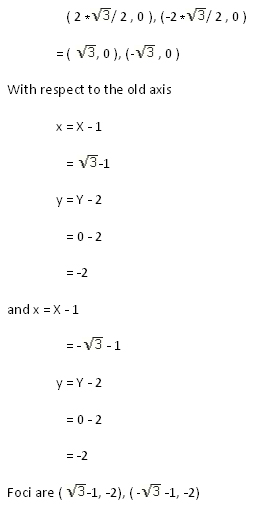
Directrices:
With respect to the new axes
